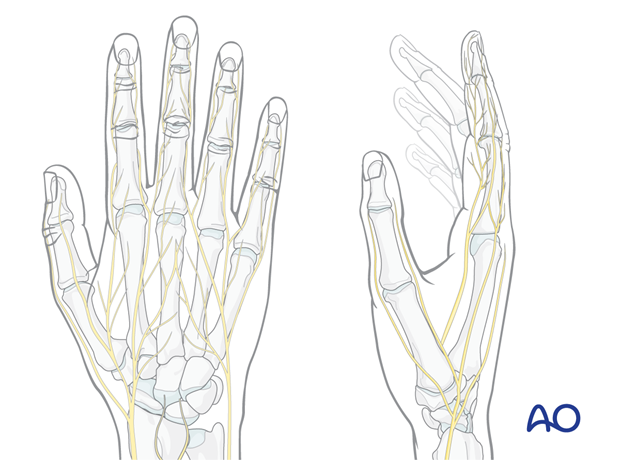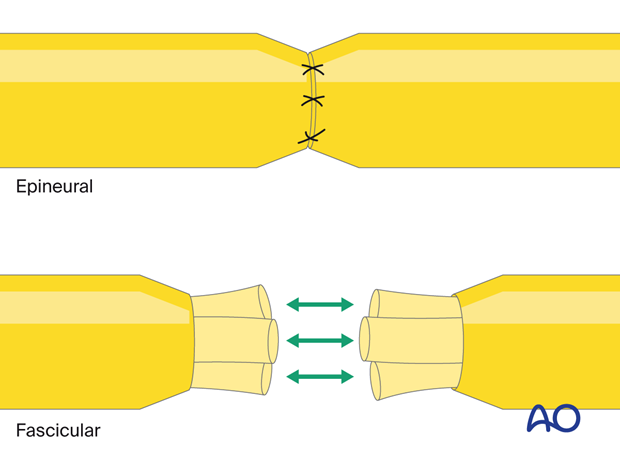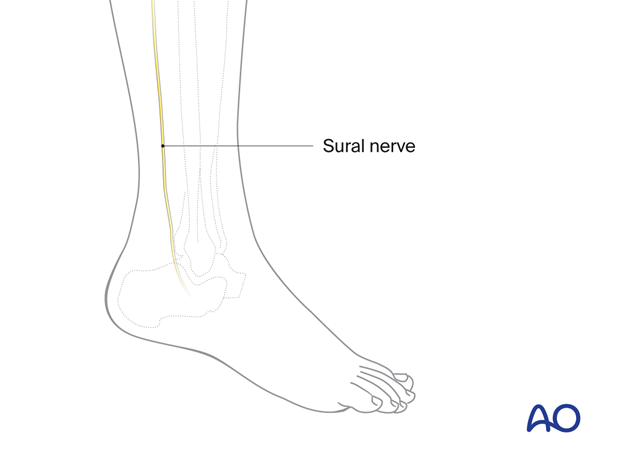Digital nerve lesions in the hand
1. Introduction
Digital nerve lesions are a common consequence of hand trauma, affecting sensation and function. Early diagnosis and operative management are crucial for maximizing recovery potential.

2. Patient assessment
History
The following should be determined:
- Mechanism of injury
- Time of onset
- Sensory loss including numbness, tingling, pain
- Associated bone and soft-tissue injuries
Physical examination
- Assessing the soft tissue injury for the likely site of digital nerve injury
- Observing for sensory deficits using light touch, temperature, and two-point discrimination
- Assessing for Tinel’s sign
Imaging is less important for the assessment of digital nerve lesions.
3. Management
- Preoperative splinting is used to immobilize the injured digit to prevent further nerve retraction and promote healing.
- Associated fractures and dislocations should be addressed before the management of the nerve lesion.
- Exploration and primary nerve repair are indicated for complete lacerations and transections.
- Neurolysis is used to release scar tissue compressing the nerve.
- Nerve grafting is used if primary repair of a large gap is not possible.
Coaptation (nerve repair)
Most commonly coaptation is performed using operating microscope or loupe magnification.
The size of sutures used depends on the size of the nerve and surgeon’s preference.
Generally, an epineural repair is performed. Proximal injuries may allow for a fascicular repair, while this is not an option for distal injuries.
Fascicular repair together with epineural repair may improve reinnervation.

The following considerations should be considered for optimal nerve coaptation:
- The ends should have enough laxity for apposition without tension.
- There should be no gap at the repair site.
- The least number of sutures that allow for adequate approximation (2–4) should be used.
- Avoid epineural tissue interposition at the coaptation site.

Some centers use fibrin glue instead of sutures.
If the nerves cannot be coapted without tension, nerve graft should be considered.
Alternatively, vein graft or synthetic neurotubes may be used.
Nerve grafting
Sensory nerves are routinely used for grafting, as they cause less functional deficits. The most common sensory nerve used is the sural nerve.
Other options are the medial or lateral antebrachial nerves.
The selected nerve is harvested.

4. Healing and Rehabilitation
Nerve regeneration is a slow process, averaging 1 mm/day.
Functional recovery can be enhanced by a specialized hand habilitation program. This would include:
- Rehabilitation of the fracture and dislocation should follow the usual principles.
- Sensory retraining; techniques to enhance the restoration of protective sensation followed by discriminatory sensation
- Occupational therapy to address functional limitations and return to daily activities

In cases of absent motor reinnervation after repair of proximal motor nerves, consider referring the patient to a peripheral nerve surgeon for evaluation of selective nerve transfer surgery which should be performed within 10–12 month post injury.

5. References
- Dunlop RLE, Wormald JCR, Jain A. Outcome of surgical repair of adult digital nerve injury: a systematic review. BMJ Open. 2019 Mar 13;9(3):e025443.
- Herman ZJ, Ilyas AM. Sensory Outcomes in Digital Nerve Repair Techniques: An Updated Meta-analysis and Systematic Review. Hand (N Y). 2020 Mar;15(2):157–164.
- Kim JS, Bonsu NY, Leland HA, et al. A Systematic Review of Prognostic Factors for Sensory Recovery After Digital Nerve Reconstruction. Ann Plast Surg. 2018 May;80(5S Suppl 5):S311–S316.
- Mermans JF, Franssen BB, Serroyen J, et al. Digital nerve injuries: a review of predictors of sensory recovery after microsurgical digital nerve repair. Hand (NY). 2012 Sep;7(3):233–241.
- Paprottka FJ, Wolf P, Harder Y, et al. Sensory recovery outcome after digital nerve repair in relation to different reconstructive techniques: meta-analysis and systematic review. Plast Surg Int. 2013;2013:704589.
- Rinkel WD, Huisstede BM, van der Avoort DJ, et al. What is evidence based in the reconstruction of digital nerves? A systematic review. J Plast Reconstr Aesthet Surg. 2013 Feb;66(2):151–164.
- Zhang Y, Hou N, Zhang J, et al. Treatment options for digital nerve injury: a systematic review and meta-analysis. J Orthop Surg Res. 2023 Sep 12;18(1):675.













